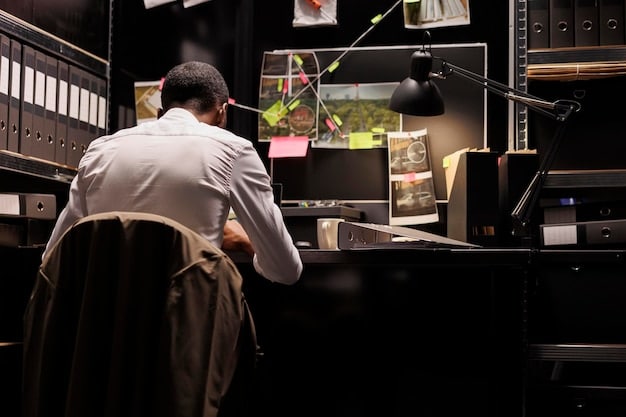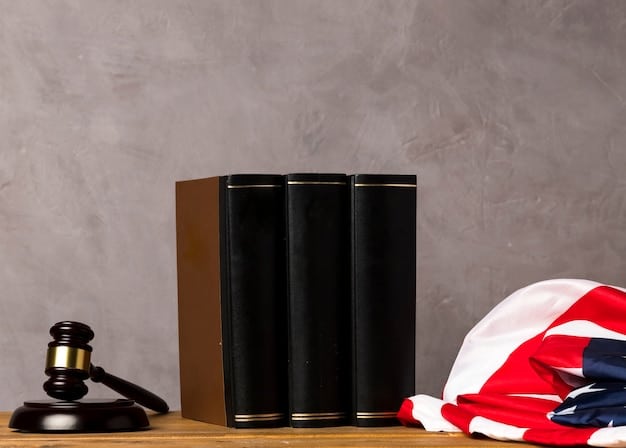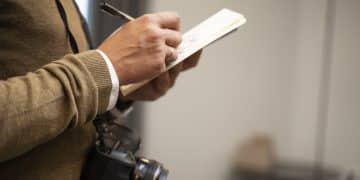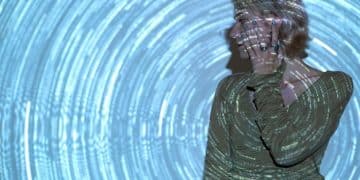Copyright Law for Online Journalists: US Content Creator Guide

Anúncios
Understanding copyright law is crucial for online journalists in the US to protect their work, avoid legal issues, and ensure ethical content creation.
Anúncios
Navigating the complexities of copyright law can be daunting for online journalists. This guide, understanding copyright law for online journalists: a comprehensive guide for US content creators, provides essential information for US content creators to protect their work and avoid legal pitfalls.
Why Copyright Law Matters for Online Journalists
In the digital age, content creation is more accessible than ever. However, this ease of access also increases the risk of copyright infringement. Understanding the basics of copyright law is essential for online journalists to protect their original work and avoid legal repercussions.
Anúncios
Copyright law grants creators exclusive rights over their original works, including the right to reproduce, distribute, display, and create derivative works. For online journalists, this means understanding how to protect their articles, photographs, videos, and other content they create.
Protecting Your Original Work
Copyright protection begins automatically as soon as an original work is fixed in a tangible medium, such as writing an article or taking a photograph. Registering your work with the U.S. Copyright Office provides additional benefits, such as the ability to sue for infringement and collect statutory damages.
Avoiding Infringement
Understanding copyright law is equally important for avoiding infringement. Journalists must be careful when using content created by others, ensuring they have the necessary permissions or that their use falls under fair use or another exception to copyright law.
- Obtain Permissions: Always seek permission from the copyright holder before using their work.
- Understand Fair Use: Familiarize yourself with the fair use doctrine, which allows limited use of copyrighted material for purposes such as criticism, commentary, news reporting, teaching, scholarship, and research.
- Cite Sources: Properly attribute all sources to give credit to the original creators and avoid plagiarism.
In summary, copyright law is vital for online journalists because it protects their original creations and guides them in ethically and legally incorporating external content.

Key Concepts in US Copyright Law
To effectively navigate copyright law, online journalists need to understand several key concepts. These include originality, authorship, ownership, and the duration of copyright protection.
Originality is a fundamental requirement for copyright protection. To be protected, a work must be independently created by the author and possess a minimal degree of creativity. This means that simply copying someone else’s work is not protected by copyright.
Authorship and Ownership
The author is generally the individual who created the work. However, in some cases, the employer may be considered the author under the work-for-hire doctrine. Copyright ownership initially vests in the author, who has the exclusive rights to control the use of the work.
Duration of Copyright Protection
The duration of copyright protection varies depending on when the work was created. For works created after January 1, 1978, copyright protection generally lasts for the life of the author plus 70 years. For works made for hire, the copyright lasts for 95 years from the year of publication or 120 years from the year of creation, whichever expires first.
- Public Domain: Works in the public domain are not protected by copyright and can be used freely by anyone.
- Creative Commons Licenses: These licenses allow creators to grant specific permissions for others to use their work while retaining copyright ownership.
- Copyright Registration: Registering your work with the U.S. Copyright Office provides significant legal advantages.
Mastering these concepts allows journalists to safeguard their intellectual property effectively and navigate the copyright landscape with confidence.
Fair Use: What Journalists Need to Know
Fair use is a legal doctrine that allows the use of copyrighted material without permission from the copyright holder under certain circumstances. It is a crucial concept for journalists, enabling them to use excerpts from copyrighted works for news reporting, commentary, criticism, and education.
Determining whether a particular use qualifies as fair use involves a balancing test, considering four factors. These factors are weighed together, and no single factor is determinative.
The Four Factors of Fair Use
The four factors considered in a fair use analysis are: the purpose and character of the use, the nature of the copyrighted work, the amount and substantiality of the portion used, and the effect of the use upon the potential market for or value of the copyrighted work.
Journalists should carefully consider these factors when using copyrighted material. Using the work for commercial purposes or using a large portion of the work may weigh against fair use. Conversely, using the work for nonprofit educational purposes or using only a small portion may support a finding of fair use.

- Transformative Use: Using the copyrighted work in a new and different way that transforms its original purpose.
- News Reporting: Using excerpts for news reporting is often considered fair use, but it must be balanced with the other factors.
- Criticism and Commentary: Using excerpts to critique or comment on the work is generally considered fair use.
Understanding and applying these fair use guidelines is essential for journalists to ethically and legally incorporate copyrighted material into their work.
Copyright Infringement: Risks and Consequences
Copyright infringement occurs when someone violates the exclusive rights of a copyright holder without permission. For online journalists, infringing on someone else’s copyright can have serious legal and financial consequences.
Copyright infringement can take many forms, including reproducing, distributing, displaying, or creating derivative works based on copyrighted material without authorization. It is crucial for journalists to be aware of these risks and take steps to avoid infringement.
Types of Infringement
There are two main types of copyright infringement: direct infringement and contributory infringement. Direct infringement occurs when someone directly violates a copyright owner’s exclusive rights. Contributory infringement occurs when someone knowingly induces, causes, or materially contributes to the infringing conduct of another.
Consequences of Infringement
The consequences of copyright infringement can be significant, ranging from monetary damages to legal injunctions. Copyright holders can sue infringers for actual damages (the amount of money they lost as a result of the infringement) or statutory damages (a fixed amount set by law). In some cases, willful infringement can result in criminal penalties.
To avoid copyright infringement, journalists should always obtain permission before using copyrighted material, understand the limits of fair use, and properly attribute all sources. Implementing these practices will protect journalists and their organizations from costly legal battles.
Best Practices for Online Journalists
To ensure compliance with copyright law and ethical standards, online journalists should adopt several best practices. These practices include obtaining permissions, properly attributing sources, understanding fair use, and conducting regular copyright audits.
Obtaining permissions is a fundamental best practice. Before using any copyrighted material, journalists should seek permission from the copyright holder. Documenting these permissions is crucial for demonstrating compliance.
Attribution and Citation
Properly attributing sources is another essential best practice. Whenever using information or content created by others, journalists should provide clear and accurate citations. This not only gives credit to the original creators but also helps avoid plagiarism.
Regular Copyright Audits
Conducting regular copyright audits can help journalists identify and address potential copyright issues. Audits should include reviewing existing content for compliance, educating staff on copyright law, and updating policies and procedures as needed.
- Use Original Content: Prioritize creating original content whenever possible.
- Document Permissions: Keep records of all permissions obtained for using copyrighted material.
- Consult Legal Counsel: Seek legal advice when faced with complex copyright issues.
By following these best practices, online journalists can protect themselves and their organizations from copyright infringement and maintain high ethical standards.
The Future of Copyright Law and Online Journalism
As technology continues to evolve, copyright law faces new challenges and opportunities. Online journalism is particularly impacted by these developments, requiring journalists to stay informed and adapt to changing legal landscapes.
One of the key trends in copyright law is the increasing importance of digital rights management (DRM) technologies. DRM systems are used to control access to and use of copyrighted material online. Journalists need to understand how these technologies work and their implications for content creation and distribution.
Artificial Intelligence (AI) and Copyright
The rise of AI also presents new copyright challenges. AI systems can create original works, such as articles, images, and music. Determining who owns the copyright to these AI-generated works is a complex legal question.
Global Copyright Issues
Copyright law is also becoming increasingly globalized. As content crosses borders more easily, journalists need to be aware of copyright laws in different countries. International treaties and agreements play a crucial role in harmonizing copyright laws worldwide.
- Stay Informed: Keep up-to-date with the latest developments in copyright law and technology.
- Adapt to Change: Be prepared to adjust your practices as copyright laws evolve.
- Engage in Dialogue: Participate in discussions about the future of copyright law and online journalism.
By staying informed and proactive, online journalists can navigate the future of copyright law and ensure they continue to create and distribute content ethically and legally.
| Key Point | Brief Description |
|---|---|
| 📝 Copyright Basics | Understanding originality, authorship, and ownership is crucial. |
| ⚖️ Fair Use | Knowing the four factors helps in ethical content use. |
| 🚨 Infringement Risks | Avoiding violations protects against legal issues. |
| ✅ Best Practices | Permissions and citations ensure compliance. |
Frequently Asked Questions (FAQ)
▼
Copyright infringement occurs when someone violates the exclusive rights of a copyright holder, such as reproducing or distributing their work without permission. It’s essential to avoid this for legal and ethical reasons.
▼
Fair use allows journalists to use copyrighted material for purposes like news reporting, criticism, or commentary, but it’s crucial to consider the four factors to ensure compliance.
▼
Obtaining permission ensures you’re not violating copyright laws and gives proper credit to the original creator. It also protects you from potential legal issues.
▼
Consequences can range from monetary damages to legal injunctions. It’s important to understand and respect copyright laws to avoid these penalties and maintain ethical standards.
▼
Best practices include obtaining permissions, properly attributing sources, understanding fair use, and performing regular copyright audits. These steps help ensure compliance and ethical content creation.
Conclusion
Understanding and adhering to copyright law is paramount for US online journalists. By mastering key concepts, following best practices, and staying informed about evolving legal landscapes, content creators can protect their work, avoid infringement, and uphold the highest standards of journalistic integrity.





